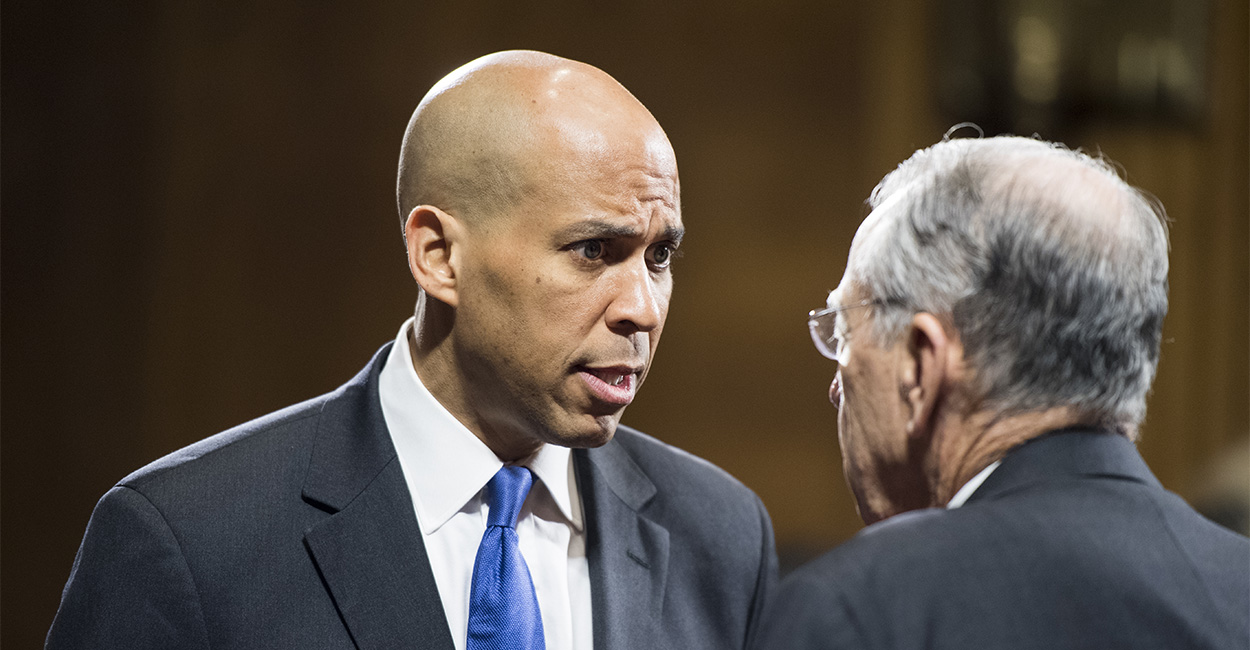 |
Cory Booker tells fellow Senator that he will never
vote for common sense.
|
This is easy to explain, progressive socialist liberal democrats are not from around here. Most people who try to answer that question of where they come from have no idea.
But where ever they are from, their collective actions to harm the country with their agenda and socialist liberal ideology is legion.
They really do mean to us all harm. Radical socialism is a historical failure and yet they demand we all must be subservient to them.
It has always been that way no matter if they are in power or out, their entire existence is dedicated to getting and keeping power no matter the consequences. How can a political existence based strictly on hate be good for the population? Are all democrats invested only in hate?
That the country will be irrevocably damaged is of no concern to progressive democrats. Just imagine out cry of rage and hate when Ruthie Ginsberg slips into the room temperature crowd. Their tactics will rewrite the definition of absolute ruthless and lawless treachery.
Again, why would anyone vote for progressive socialist liberal democrats? Why would anyone actually and willingly vote for self destruction? Who votes for hate?
By Democrats’ Own Standard, We Have a Judicial Vacancy Crisis
Words like “crisis” are in the eye of the political beholder. But it’s hard to pick a better one to describe the current state of vacancies in the federal courts.
Today, 126 positions on the U.S. District Court and U.S. Court of Appeals are vacant. In fact, we’re in the longest period of triple-digit vacancies in 25 years. But the raw numbers don’t tell the full story, so, since the partisan environment is so bitter, let’s apply some standards advocated by Democrats to put these numbers in perspective.
Vacancies today are 52 percent higher than when Sen. Cory Booker, D-N.J., declared a “vacancy crisis” in July 2016. They are 88 percent higher than in September 2015, when then-Judiciary Committee Chairman Patrick Leahy, D-Vt., warned that “we are heading into a judicial vacancy crisis.”
In April 2014, Leahy also said it was fair to compare vacancies today with vacancies at the same point in previous administrations. Vacancies are 16 percent higher than at this point under President Barack Obama, 110 percent higher than under President George W. Bush, and 103 percent higher than under President Bill Clinton.
The Administrative Office of the U.S. Courts designates as “judicial emergencies” the vacancies that have been open the longest and have the most negative effect on the caseloads of sitting judges.
In March 2012, Democratic Whip Richard Durbin, D-Ill., said that 35 judicial emergency vacancies would cause the administration of justice to suffer “at every level.” Not only are judicial emergencies 80 percent higher today, but they have been open an average of 24 percent longer than when Durbin warned about this crisis.
Approximately 45 federal judges leave their position each year, and Senate Democrats have complained when judicial confirmations do not keep up with attrition—at least when there is a Democratic president. Vacancies today are 17 percent higher than when President Donald Trump took office. Four of the previous five presidents saw vacancies decline by an average of 24 percent at this point.
In November 2013, Democrats said that taking separate votes to end debate on unopposed nominees was “obstruction and abuse of Senate rules.” After all, if no senator opposes the nominee, it should be easy to schedule a quick confirmation vote without the formal process of filing and voting on a motion to end debate.
At that point, four years into the Obama administration, the Senate had taken just one such cloture vote on a judicial nomination. Today, just two years into the Trump administration, Democrats have forced the Senate to take cloture votes on 12 judicial nominees who were later unanimously confirmed.
There’s more where these came from, but the point should be obvious. Under any standard used by Democrats in the past, the current sustained level of judicial vacancies is a serious problem—and its cause is equally clear. Even though Trump’s nomination pace, and the Judiciary Committee’s hearing pace, is ahead of previous presidents, confirmations lag and vacancies remain high.
As Leahy put it in 2014: “Such obstruction is not worthy of the Senate, and the resulting judicial vacancies do great harm to the judicial system.”
The Senate has confirmed judges during 10 of the 11 lame-duck sessions following a midterm election since World War II. The last two, in 2014 and 2010, the Senate confirmed an average of 23 judges. While it doesn’t look like even that’s going to happen in the closing days of the 115th Congress, a larger Republican majority in the 116th must push forward to address this vacancy crisis.
Originally published by The Washington Times

No comments:
Post a Comment